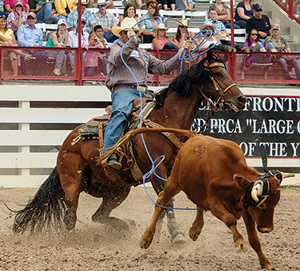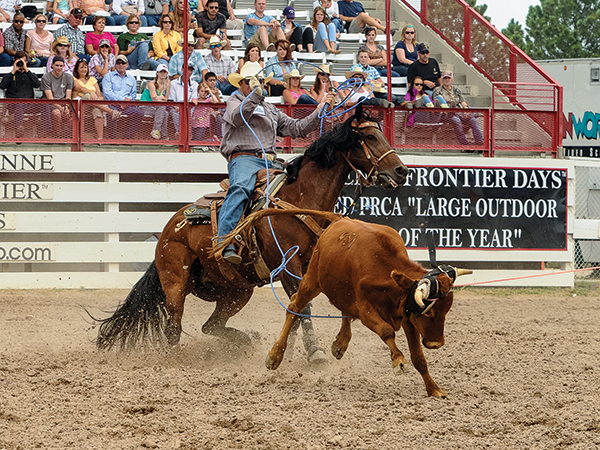In the horse dictionary, Fines Snip of Doc “Caveman,” Jade Corkill’s two-time PRCA/AQHA Heel Horse of the Year, could be pictured next to the definition of tough. How tough is he? The 14-year-old gelding passed a flex exam despite having torn suspensory ligaments in both hind legs.

Though Caveman wasn’t showing any outward signs, Corkill could tell something wasn’t quite right with his top horse.
“I guess that’s the good part, as far as rodeoing goes. You do spend so much time with them,” Corkill said. Then he explained the subtle signs Caveman showed him back in August 2012,
“He’s really, really calm in the box. He just stands there. He was still that way, but I could feel his heart beating in the box. I could tell something was bugging him in there. That’s what made me think it was his hocks, because the times he would push off leaving the box or when I would throw and he would stop, I could feel him kind of tighten up.”
Corkill took Caveman to a vet in Nevada to see if he needed his hocks injected, but he passed the flex exam.
“I hated to even say anything, but it was just one of those deals—more intuition—but I just knew something wasn’t right with him,” Corkill remembers.
In an effort to figure out what was wrong, the vet started going through Caveman’s whole body with the ultrasound machine. What he found was surprising and severe: both hind suspensory ligaments were torn.
“He couldn’t believe that [Caveman] did what he did. It amazed me as much as it did him. It’s crazy they can be that tough,” Corkill said. “I thought back and nothing came to mind. I couldn’t think of anytime that he would’ve done it when I was on him. I don’t know if maybe he did something in the pen or it was just something that was gradual over time and eventually got to the point where it happened.”
After giving Caveman almost a year-and-a-half to recover and then being back to competing on him again, Corkill experienced a similar incident with the horse who masked his pain so well.
“Last year—once again I didn’t even know that he did anything to himself—I just took him to Josh (Dr. Harvey at Outlaw Equine) just to see if his suspensories were still good. And he thought his right, hind ankle looked a little bit puffy, so he flex tested him and when the girl went to lead him off, he wouldn’t even go.”
Dr. Harvey diagnosed Caveman with Hemarthrosis of the right hind fetlock joint. Caveman had suffered an articular strain severe enough to have bled into the joint.
The three-time world champion team roping heeler had just ridden Caveman two days before that at the rodeo, but the reality of that never happening again was a possibility.
“Dr. Harvey said, ‘This one will be up to [Caveman] because it’s so bad. It could go either way. We’ll just have to wait and see.’ And sure enough, I’m getting to ride him still,” Corkill said.
It was a long road of rehab though, and Dr. Harvey credits part of the success to being aggressive, “My guess is that Jade got him here within 48 hours or sooner of the injury. We got it diagnosed and treated. It’s always a race to get the inflammation out.”
Dr. Harvey also said that Caveman spent a couple weeks at Outlaw Equine, and part of the rehab consisted of cold salt-water chamber and an IRAP series (Interleukin-1 Receptor Antagonist Protein), which is a process of injecting the joint with the horse’s own blood, which utilizes the horse’s anti-inflammatory mechanisms.
While talking about Caveman, Dr. Josh Harvey also said, “All these horses are just warriors—Caveman, Switchblade, Jackyl. Some of these rodeo horses have an amazing ability to heal faster and quicker than a normal horse. Not only is he just tough, he’s stayed together better which I think is genetically bred in them.”
While recovering, Caveman spent a couple months with Danita Walker, who is Wrangler NFR barrel racer Carlee Pierce’s mom. She put him on the TheraPlate and did laser therapy. Then during the Dodge City Roundup this year, Corkill got Caveman back. He’s now selective where and when he rides him, “I just try to haul him where I’ll need him the most. I just let him tell me if he feels good then I ride him, and if he doesn’t, then I give him time off. I just kind of let him call the shot now.”
Corkill knows how valuable Caveman is.
“I’ve had a bunch of horses that have been good, and I’ve had two or three that have been real good. He’s just different than anything I’ve ever had. It just seems like there’s nothing that any steer or anything can do that he doesn’t make it easy for me to catch. I’ve probably caught more steers on him than anything I’ve ever rode.”
To explain the qualities that make Caveman different, Corkill said, “I would say his speed. He’s probably the fastest one I’ve ever rode. And he’s smart. His cow sense of where to be and his timing of when to be there is something that is different than probably any horse I’ve ever rode, too. He’s made hard shots easy for me—even when he’s hurt. I rode him for probably three months and didn’t even know he had torn suspensories. The ones that are like that—that just do their job no matter what and try to do whatever they can to help you and not take it away from you—are hard to find.”











